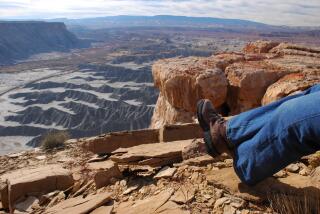State Funding Urged to Save Open Spaces
- Share via
SACRAMENTO — California’s largest philanthropic foundation said Wednesday that ominous growth threatens to devastate the state’s remaining open spaces, and called on Gov. Gray Davis to make land preservation an urgent priority.
The plea came as the David and Lucile Packard Foundation released a midterm report on its ambitious five-year drive to protect farmland, wildlife habitat and other threatened acreage around the state.
The report shows that the foundation already has surpassed its initial conservation goal by saving 327,000 acres--an area about 10 times the size of San Francisco--from bulldozers.
But the philanthropists view that accomplishment--an investment, with matching funds, of $341 million--as a “down payment” and said state government should commit significant money now to a permanent land acquisition fund.
“The need is urgent,” said Jeanne Sedgwick, director of the foundation’s conservation program. “There are 25 million new Californians coming in the next 40 years, and if we don’t get on top of this now, we’ll be buried.”
Sedgwick said the foundation’s board is so concerned about California’s fast-dwindling open space that members have agreed to double their investment budget and expand the conservation effort to half a million acres.
State Resources Secretary Mary Nichols called the bequest the single largest financial contribution toward land preservation in the state--by far--and praised the foundation’s strategy.
“They are not just preserving parcels of land that their trustees happen to like,” Nichols said. “They have a very sophisticated way of setting priorities and it makes them a wonderful partner for the state.”
When launched in 1998, the foundation’s effort was called one of the most expansive conservation campaigns in history, rivaling bequests by the Rockefeller family early in the 20th century that helped establish and expand national parks.
Packard’s approach is to use its contributions to draw matching funds from private and public donors. The foundation has contributed about $96 million in grants and low-interest loans; other sources have given $245 million.
About $50 million came from a handful of wealthy individuals in the Silicon Valley, many of whom had not previously participated in land preservation.
Among the land the foundation helped preserve was a spectacular six-mile stretch of coastline south of San Francisco. A developer held an option on the property and was poised to build luxury homes. Foundation grants allowed a nonprofit group to purchase the developer’s option and later helped the Trust for Public Land buy the parcel and turn it into a 7,000-acre preserve.
Also aided by Packard money were numerous wetland acquisitions, efforts to restore salmon and steelhead runs to various streams, projects to enhance waterfowl habitat in the Central Valley and preservation of wilderness on Mt. Hamilton near San Jose.
While celebrating the early achievements, the foundation’s report rings a loud alarm about the challenge confronting California, which, by 2040, will need to absorb as many residents as live in eight cities the size of Los Angeles.
“As the human footprint expands, what is left of the natural community? What happens to the quality of life?” the report asks. Only a broad-based buying spree spurred by hearty public investment can save enough land to prevent ecosystems from collapsing under the onslaught of development, the foundation warns.
Over the last decade, the report says, 138,000 acres of California farmlands have been lost to urban sprawl, an increase of more than 50% from the previous decade. In the Sierra Nevada, 50% of the remaining private lands are expected to be developed by 2040.
Sedgwick said that, given the projected state budget surplus of $10.6 billion, Gov. Davis ought to commit at least $1 billion to a land preservation endowment, with the interest paying for purchases on an ongoing basis.
Steve Maviglio, a spokesman for Davis, said that “protecting open space and preserving California’s quality of life is a top priority for the governor.” The Davis administration, he said, is now evaluating requests to include funding for open space in next year’s budget.
Earlier this year, the governor encouraged conservationists with two actions. He supported the multibillion-dollar park and water bonds passed by voters in March and earmarked $75 million in matching fund money to purchase habitat and open space.
Sedgwick said the $75 million was “an important drop in the bucket, but it’s still just a drop.” One study estimates that it would take $12.3 billion to buy the 5.4 million acres of critical habitat in need of preservation in California.
The foundation’s effort comes at a time of increasing public anxiety over sprawl. On election day, ballots were brimming with local measures aimed at limiting growth. One recent poll showed that 59% of Californians think their region is growing very rapidly; 57% favor using tax dollars to buy open space.
Rather than buying land outright, the foundation tends to fund easements that allow acreage to remain privately held, but with the owner committing to deed restrictions that allow public access, protect habitat or permanently retain the land in farming. The foundation covers a maximum of 50% of each transaction’s costs to ensure the participation of other partners.
Spending is focused in three areas--the Central Coast, Central Valley and Sierra Nevada. Those regions were targeted because they are forecast to bear the brunt of the coming growth and because of their wealth of agricultural, biological and scenic resources. The Packards also wanted to focus their giving in the area where they earned their wealth through Hewlett-Packard Co.
Preserving California
The David and Lucile Packard Foundation released a report on its initiative to preserve farmland, wildlife habitat and other threatened land in California. Purchases of land so far:
Source: David and Lucile Packard Foundation
More to Read
Sign up for Essential California
The most important California stories and recommendations in your inbox every morning.
You may occasionally receive promotional content from the Los Angeles Times.










